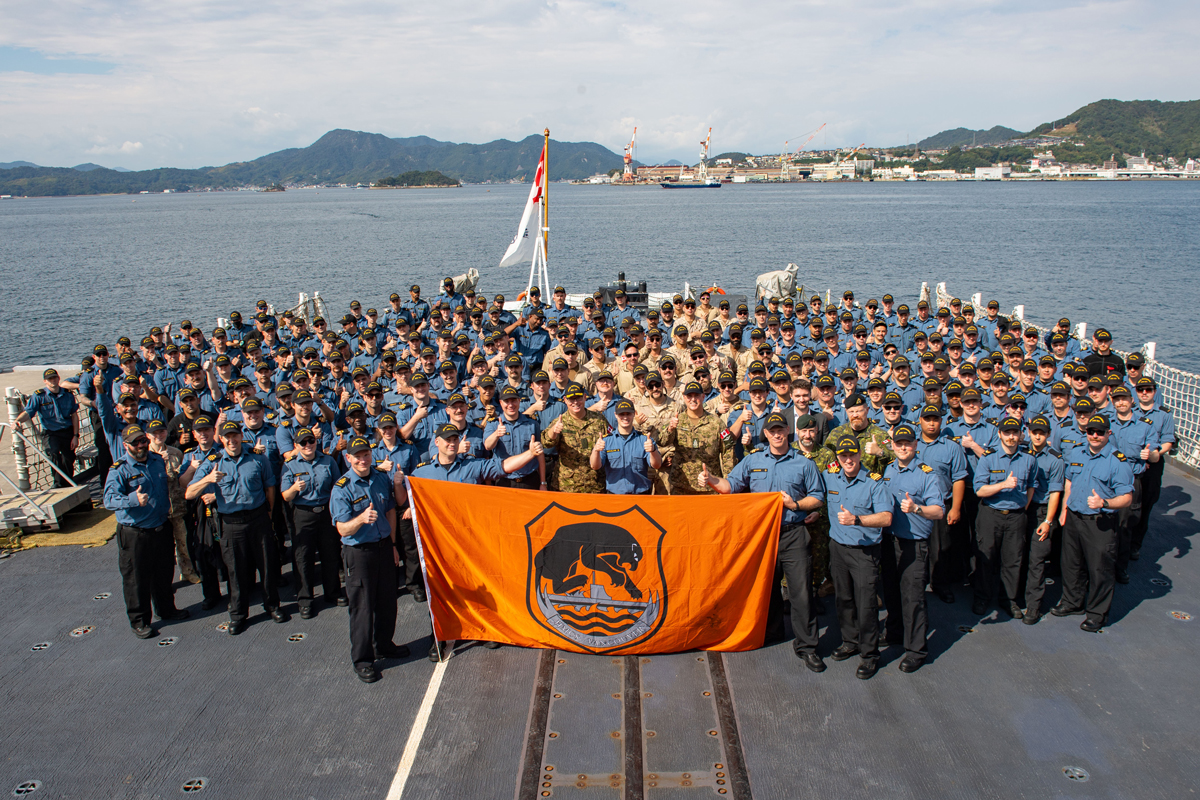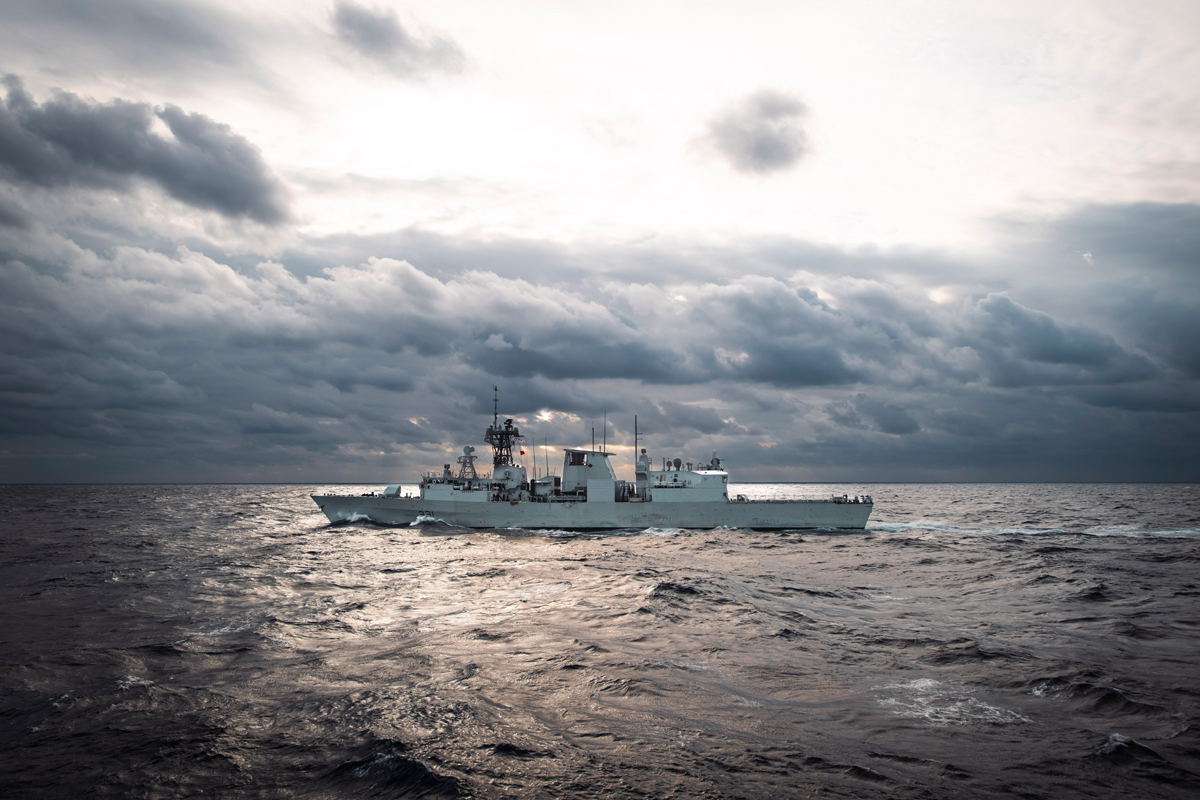HMCS Vancouver concludes Operation Neon
By Lookout Production on Nov 24, 2022 with Comments 0

HMCS Vancouver’s ships company in Japan as they complete Operation Neon. Photo: Lieutenant (Navy) Michelle Scott
Lt(N) Michelle Scott,
HMCS Vancouver PAO
—
Searching the East China Sea and Yellow Sea for Vessels of Interest (VOI) and sanctions evasion activities is no easy task.
But for Sub-Lieutenant (SLt) Henry Wong, a Bridge Watch Keeper under training in HMCS Vancouver, it was a learning environment unlike any other.
“I was part of the team identifying vessels; we had many tools at our disposal, but it was definitely more challenging serving in this role during Op Neon,” SLt Wong said.
Pulling into Kure, Japan, on Oct. 21, His Majesty’s Canadian Ship (HMCS) Vancouver finished its support to Operation (Op) Neon after 31 days.
This was Vancouver’s first deployment on Op Neon, Canada’s contribution to a multinational effort to implement United Nations Security Council Resolution sanctions imposed on North Korea.
SLt Wong and the rest of the Bridge team were tasked with searching the waters in some of the busiest commercial lanes in the world. Meanwhile, members of the Operations Room searched the water and airspace beyond the Bridge team’s visual horizon through radars and sensors.
“There is difficulty operating in such a dense littoral environment,” said Sailor First Class (S1) Seamus Bowkett, a Naval Combat Information Operator in Vancouver.
S1 Bowkett, a Track Supervisor in HMCS Vancouver, provided information to the Operations team to build and maintain a complete air, surface, and sub-surface picture to analyze and locate contacts.
Given the density of the vessels operating in the area, it can be compared to searching for a needle in a haystack. That’s where Vancouver’s CH-148 Cyclone helicopter, Canuck, comes in.
“As we patrolled for particular ships, or other vessels carrying out suspicious activities, we were quite busy sorting between all the contacts on our sensors to decide which ones were the most important to investigate. On one busy day, we picked up over a thousand different contacts,” said Captain (Capt) Tyler Molloy, an Air Combat Systems Officer in HMCS Vancouver.
Canuck provides Vancouver with the invaluable capability of reaching out much further than the ship’s sensors and radars, serving as a force multiplier. However, more ground to cover means more potential VOI to investigate.
Capt Molloy said the aircraft had to adapt its tactics due to the sheer number of vessels in the East China Sea.
“As an aircraft, we could range quite far from the ship and cover a lot of ground quickly, but this means prioritizing our time and energy to make the most of each flight,” he said. “When we wanted to examine a ship, it meant we had to fly low over the water with the helicopter’s door open, camera in hand, looking for any evidence of suspicious or illegal activity.”
S1 Bowkett said the Operations team was utilized to the fullest during every watch.
“It is always more challenging to operate on a deployment, but this is where we do our actual job and fulfill our role to the Government of Canada,” S1 Bowkett said.
Despite the increased stressors on the team during Neon, SLt Wong enjoyed the experience.
“Travelling through the East China Sea was fun, seeing all the fishing vessels and floats at night made the open ocean look like a city skyline at times,” he said. “It kept us very busy during our watches, ensuring we kept our ship safe, but also ensuring we weren’t intruding on the work of fishing vessels.”
HMCS Vancouver is currently deployed on Operation Projection for six months, conducting forward naval presence operations in the Indo-Pacific and participating in international exercises with partner nations. The ship is expected to return to Esquimalt in early December.
Primarily a surveillance operation, Operation Neon sees ships and aircraft conduct patrols looking for vessels of interest (VOI) that are known to participate in maritime sanctions evasion activities, such as ship-to-ship transfers of illicit materials. Units collect evidence on VOI and intelligence on activities to build the pattern of life in the East China Sea and the Yellow Sea. This information is then reported to the Enforcement Coordination Cell (ECC) and eventually makes its way to the United Nations, where they analyze it to evaluate cases of non-compliance.
The ECC is staffed by personnel from Canada, Japan, the U.S., France, Australia, Germany, the U.K., New Zealand, and others, all working together to deter North Korea’s weapons of mass destruction programs and to respond to North Korean nuclear weapon tests and ballistic missile launches.
Filed Under: Top Stories
About the Author:






